If you have even a passing interest in Sega and Sonic during the nineties, you probably know the story of how the company struggled to get the blue hedgehog onto the Saturn. Of the three Sonic games that were actually released, there’s Sonic 3D Blast, a graphically unremarkable isometric adventure that was originally designed for the Mega Drive/Genesis, with the Saturn port featuring 3D special stages based on Sonic 2. And there’s also Sonic Jam, a compilation of Sonic’s mainline 16-bit outings, which also offers a modest 3D environment for players to explore.
Sonic R is the Saturn’s only release that puts the spiky hedgehog in a true 3D environment and builds the whole game around it. There are no gimmicks and no excuses. This is a Sonic game that’s every bit as 3D as the other racers of its era, from PlayStation and Nintendo 64 exclusives to Sega’s own Sega Rally Championship and Daytona USA. Fatefully, it also attempts to be more than just a racing game, with pre-release coverage with developers revealing its ambition as a “platform adventure” game. This was presumably meant to give players a taste of the exploration that Mario, Lara Croft, and Crash Bandicoot had already, by 1997, been enjoying for a full year.
As early as the start screen, Sonic R seems intent to always give you something 3D to gawk at. Rotating 3D objects accompany every selection on the main menu, which is where you’ll choose between Grand Prix, Time Attack, Two-Player and Options modes. Despite its name, Grand Prix mode doesn’t actually take you through the game’s four initial circuits (plus the unlockable fifth) one after another. Instead, each race is treated as a one-off, and how you perform in one won’t affect how you perform overall. So, pick a course, pick a character, and get ready to race. The short loading screens feature a rotating, reflective Sonic head, which looks great and is almost definitely a result of the programmers showing off.
To this day, Sonic R is ridiculed for its music, which is generally regarded as “so bad it’s good.” Making full use of CD audio, these tracks were composed by Richard Jacques, with vocals by T.J. Davis. There are seven of them, and with names like “Can You Feel the Sunshine?” and “Diamond in the Sky,” you’ll have a good idea of how saccharine they are without even needing to know the lyrics. But what all these tunes have, like later work by Crush 40, is such passion and self-belief that it’s hard not to be won over. One man’s cringe is another man’s treasure, and while the game allows players to turn off the vocals, I can’t imagine playing Sonic R without them.
Sonic R‘s presentation, different than from what you might expect in a Sonic title, is the result of the game being the product of two developers. Original series creator Sonic Team handled creative elements such as course design, while British studio Traveller’s Tales took care of technical aspects like programming. It’s a similar set-up to Sonic 3D Blast, which came out a year earlier and was co-developed by the same two teams. From a technical standpoint, the game earns its reputation as a tour de force. The Saturn draws complex 3D circuits with far more ease than the system is known for, and even when your character hits a speed pad that shoots them forward at twice the normal speed, the game runs at a mostly stable 30 frames-per-second. Slowdown does happen, but it’s rare.
First-time players will probably jump right into the game’s first course, Resort Island, as Sonic himself. Once it loads, you’ll see grassy hills, a loop de loop, and a flock of Flicky birds flying overhead as the racers wait at the starting line. It’s a pitch-perfect introduction to a Sonic racing game, at least until you start moving. Sonic R features five main racers: Sonic, Tails, Knuckles, Amy, and Eggman. The first three race on foot, the last two in vehicles, and all of them can be moved forward by either holding up on the D-pad, or the B button. For characters who move on foot, holding up feels more natural, but without a 3D control pad this quickly becomes uncomfortable, so it probably won’t be long before you’re using the B button to accelerate them like they’re a car on legs. To navigate bends and corners, you can either drift by holding the L or R button, or brake by pressing both L/R buttons at the same time. These controls rarely feel great, and they never feel precise.
Courses in Sonic R are fairly labyrinthine, with numerous shortcuts and side roads, some of which are gated until you or an opponent unlocks them by collecting enough rings. When it comes to the actual racing, none of this is terribly exciting. If you see a shortcut, you should probably take it, but if you miss it, there’s still every chance you’ll win. Unlike the best of Sega’s arcade racers, there’s no bend that’s satisfying to tear through, and no corner that’s punishing enough to fear. A lot of talent has gone into making these tracks not just a Saturn showcase, but also masterfully on-brand, with inspiration pulled from Green Hill, Chemical Plant, Aquatic Ruin, and other iconic zones. The problem is that they’re not very fun to zip around, especially once the novelty of playing Sonic and friends in 3D has passed.
A genuine effort has been made to give every racer their own strengths and weaknesses, although in practice, more problems arise. Of the initial five racers, Tails is absurdly floaty but can hover above obstacles; Amy’s sluggishness is somewhat mitigated by a turbo boost; and Eggman can slow down faster racers using homing missiles, which are the game’s sole offensive weapon. Sonic is the fastest racer and Knuckles has the best handling, so no matter what course or mode you’re playing, there’s usually no reason to pick any other character. But for those who do like self-imposed challenges, it can be rewarding to get to grips with the other characters. At first, it’s not obvious how you can beat better racers in Amy’s beat-up car, but with practice and patience, it’s possible.
The racing might be lackluster, but how does the “platform adventure” side of things hold up? In Sonic R, there are two sets of collectibles that give players a reason to explore each course. The chaos emeralds are one type. Collect all seven and you’ll unlock Super Sonic, whose superior speed is a worthy reward. While not especially well-hidden, these emeralds do force you way out of the usual racing line. What’s more, if you nab the emerald but don’t win the actual race, you don’t get to keep the emerald. This handicap makes for a more exciting, if innately unbalanced, racing experience. If Sonic R has thrills, this is one place where you’ll find them.
The other type of collectible is Sonic tokens. There are five of them on most courses, and unlike the chaos emeralds, they’re hard to find and will often force you to do some fancy footwork, including jumping, to grab them. Once you have them all and finish the race, a 1v1 showdown begins between you and either Metal Sonic, or three other robots based on Tails, Knuckles and Eggman. These robots have a higher base speed than even Sonic, so you’ll be fighting to stay ahead and claim your victory. If you do, you’ll unlock your opponent as a playable character. Whether you’ll actually want to play these soulless robots is another question entirely, but for completionists, it helps extend the game’s meager length.
Two or three hours is all you’ll need to see most of what Sonic R has to offer. Getting to the credits of Grand Prix mode can be done in half an hour, and it doesn’t take much longer to find all the collectibles. The game’s Time Attack mode is actually a set of four modes, these being your standard three-lap time trials in Normal and Reverse, Balloon Mode that involves finding five balloons on a course as quickly as possible, and Tag Mode, which has you chasing down and making contact with four other characters. These are all thoughtful embellishments, but they do very little to overcome Sonic R’s gameplay shortcomings. Likewise, there’s little reason to fire up two-player mode in this game as opposed to a superior Saturn racer.
Despite all of this, Sonic R is a likeable and well-produced game, with more potential than it achieves. Radiant Emerald is the game’s unlockable fifth course, and it remains a stunning technical accomplishment. Here, the whole length of the track is a translucent purple or green, proving that the Saturn could handle transparencies, even if the mesh shadows are still here. It’s the fastest track in the game and also the simplest, with no collectibles and minimal side routes. When the game ditches its ill-fated ‘platform adventure’ design philosophy, and when it offers up a track wide enough that the loose controls are actually satisfying, it provides just enough brilliance for Sonic fans and Saturn lovers to finally feel the sunshine.

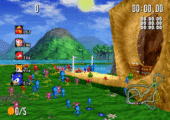
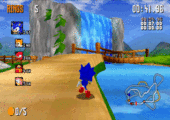
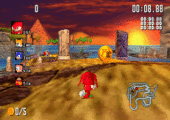
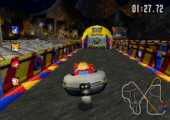
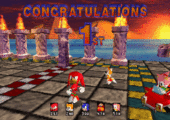
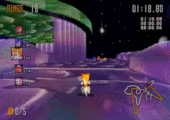
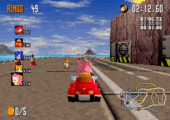
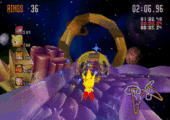
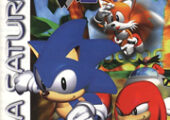
Recent Comments